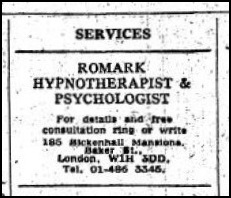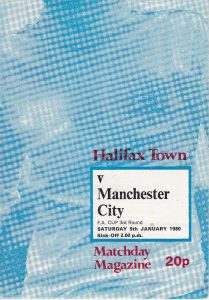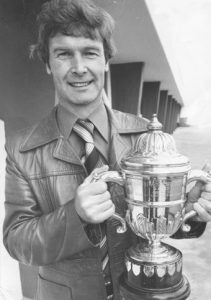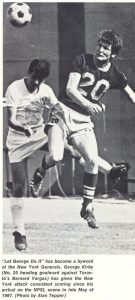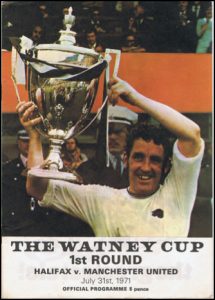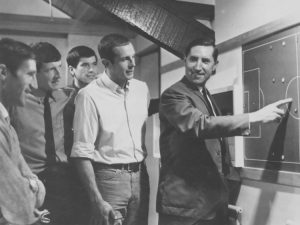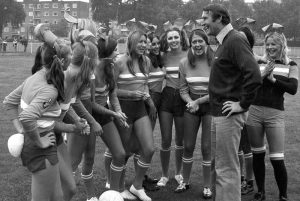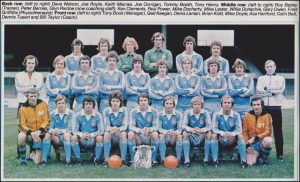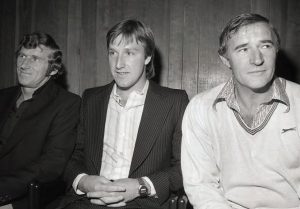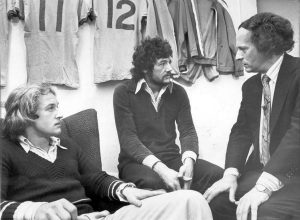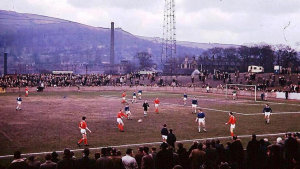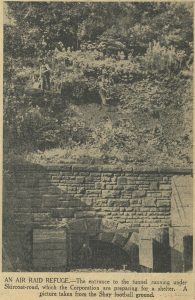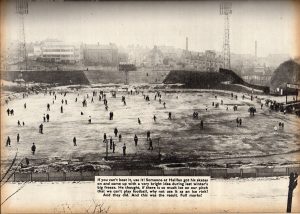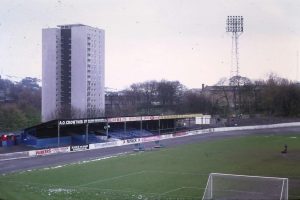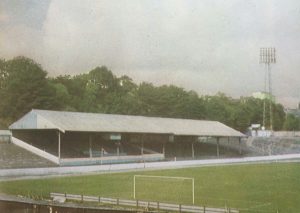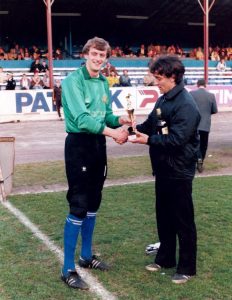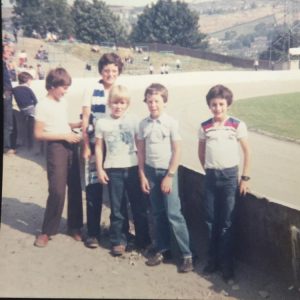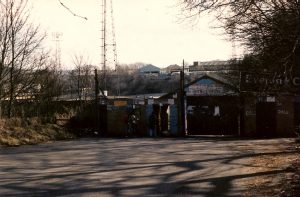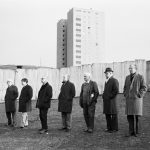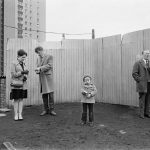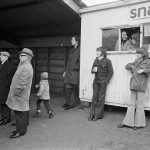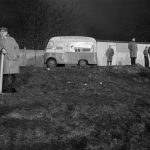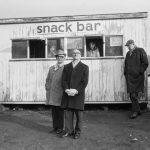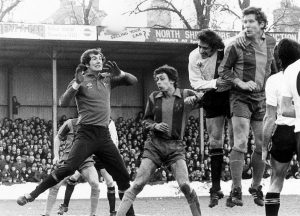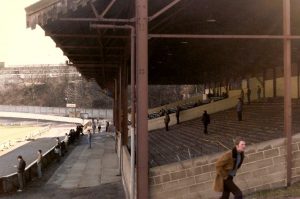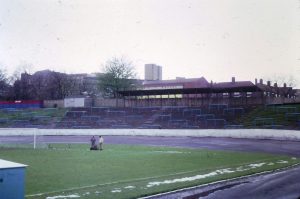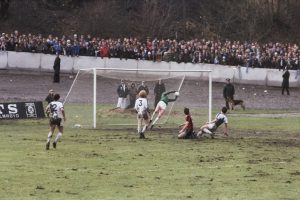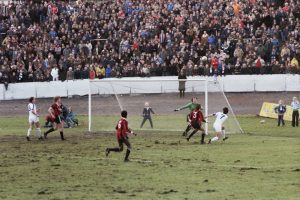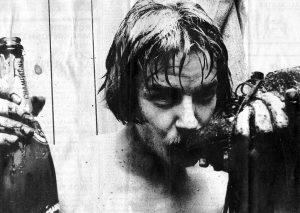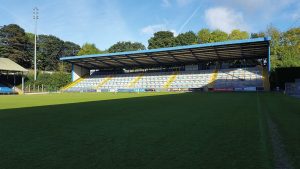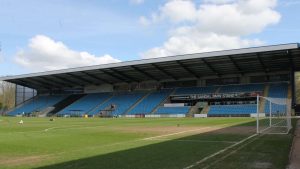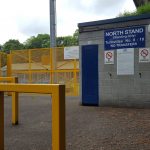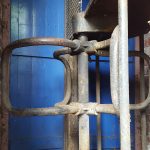Halifax Town 1 Manchester City 0
FA Cup, 3rd Round
5 January 1980
The context
This game disproves the theory that history is written by the victors. In the intervening four decades a generation of journalists have focussed almost exclusively on Big Malcolm Allison while hardly noticing the enigmatic figure of George Kirby.
Town’s Scouse manager was usually described euphemistically – well travelled, no-nonsense, uncompromising. As a player he rarely stopped anywhere long, turning out at centre-forward for eight League clubs in a 17-year League career in which he scored a goal on average every three games. A quiet, polite man off the pitch, once over the line Kirby became a different beast altogether. Southampton fans recalled the day his enthusiastic challenge for a Terry Paine cross led to three Swansea defenders needing treatment, and another occasion on which an enraged George put Billy Bremner to flight. He had spent his final season playing for the New York Generals and his coaching record already featured spells in Iceland and Kuwait.
Halifax in January was only marginally warmer than Iceland but it held fond memories. Back in 1970 the Shaymen were on the up after their first-ever promotion to Division Three, and when – after a year as coach – Kirby took over as manager from the only slightly less nomadic Alan Ball senior, he injected fresh vibrancy into the club. In came a jazzy tangerine strip (occasionally worn with numbers on the front like the shirts he had worn in New York). Out went Ball’s ultra-conservative style, to be replaced with a system that liberated wingers Dave Chadwick and Phil McCarthy and harnessed the goalscoring prowess of Bill Atkins. The team scored 74 times in 1970-71 and finished third, their highest ever placing.
Sadly only two clubs were promoted that season and so Town stayed in the 3rd Division. Their exploits merely qualified them for the pre-season Watney Mann Invitation Cup, a quintessentially Seventies affair contested by high-scoring but otherwise average sides. As well as being the Football League’s first sponsored trophy, it introduced the penalty shoot-out to Britain and was notable for imaginative tinkering with the off-side rule – and, in Halifax, for bringing Manchester United to the Shay Ground. This was a United team who had won the European Cup just three years previously and Frank O’Farrell fielded a full-strength side including Best, Law and Charlton. But on a famous day for the Shaymen the visiting stars left on the wrong end of a 2-1 defeat.
Kirby allowed himself to bask in this limelight for precisely a week before accepting the challenge of keeping Watford in Division Two. He failed spectacularly at Vicarage Road, it must be said through no real fault of his own, and packed his bags for Iceland. This seems to have become his spiritual home. A spell at ÍA Akranes between 1973 and 1974 ended with them lifting the League title and he would eventually return to the port town three more times, winning the Icelandic Cup twice and managing the Skagamenn on periodic forays into European competition. Kirby’s second Seventies spell at the Akranesvöllu sandwiched a short sojourn in that honeypot for Seventies coaches, the Middle East. In this he followed his old adversary O’Farrell, manager of the Iranian national side since 1974.
Which brings us to to Malcolm Allison. As 1972 became 1973 and O’Farrell’s United plummeted towards relegation, across the city Big Mal was also in trouble. He’d been manager at Maine Road for just a few months after seven years as coach, and was licking his wounds following an attritional civil war with his predecessor and long-time mentor Joe Mercer. This conflict saw Allison’s flawed ambition – personified by the marquee signing of Rodney Marsh in March 1972 – sacrifice a League title, drive Mercer out of the club and destroy a team ethic that had garnered four trophies in three seasons. It was an extraordinary time even for a confident character who also attracted his share of stock adjectives. “Outspoken”, “flamboyant”, “controversial” – cigar-smoking, champagne-quaffing, womanising Allison was all these and more.
Allison resigned in the spring of 1973 and moved to Crystal Palace. He left behind a fractured club for Ron Saunders to inherit. At Selhurst Park he oversaw two relegations and blew an apparently nailed-on promotion, yet somehow manages to be remembered as a success. Partly this was due to a spectacular run to the FA Cup semi-final in 1976, but to an equal extent it was smoke and mirrors abetted by the sweeper system, his habit of wearing fedora hats and a dressing-room press stunt with porn actress Fiona Richmond. From Palace he went to Turkey and managed Galatasaray for a year, then returned to his coaching roots at Plymouth. This novelty soon wore off and he was out of work when, in late 1979, Manchester City chairman Peter Swales came calling.
On the face of it this was a strange move. City had, after all, been doing rather well without him. Tony Book – Allison’s captain at Bath City, Plymouth and at Maine Road – took over as manager following Saunders’ brief tenure, reached a couple more Wembley finals and came close to breaking Liverpool’s title hegemony. Crowds at Maine Road rivalled those at Old Trafford, and Book’s talented young team was widely admired for its entertaining style. But Swales was ambitious. He wanted a final push for dominance over both Liverpool and United, and after a relatively average 1978-79 season he doubted Book’s capacity to deliver it. So Big Mal was reinstated and, like Mercer, Book found himself shunted upstairs.
Allison set about spending a generous transfer budget in the style of Johnny Appleseed crossing Pennsylvania. He signed a raft of unproven players – Bobby Shinton, Michael Robinson, Steve MacKenzie, Dragoslav Stepanovic, Stuart Lee – and paid a record fee for Wolves’ only slightly less average Steve Daley. He sold established talents Gary Owen, Asa Hartford, Dave Watson and Peter Barnes. And he fell out publicly with Mick Channon and ended up transferring him to Southampton. All this took place in a bizarre alternative reality where Shinton was described as “the new Mike Summerbee” and the famous sweeper system was recreated around such unlikely liberos as Nicky Reid and Barry Silkman.
The first half of the season didn’t go well and City were fifth from bottom going into Christmas. The FA Cup draw on 17 December came as a welcome distraction. In the event they didn’t discover their Third Round opponents until Christmas Eve because Halifax took two replays, both at home, to dispose of Fourth Division rivals Walsall. In truth the Shaymen didn’t seem much of a threat. Kirby was keeping them clear of the re-election zone and that represented progress after their form in recent years, but of his side only Geoff Hutt, Paul Hendrie and David Evans had played at the top level and the rest were youngsters like Mick Kennedy and familiar lower-league faces such as Chris Dunleavy, Bob Mountford and Franny Firth.
The weather had been bad in Yorkshire. Early January saw snow turning to slush – and mud. Although the Shay pitch was in a shocking state, that was no great advantage because Maine Road’s wasn’t much better. But Kirby held another card against Allison. Shortly before the game he was visited by the hypnotist Romark. The psychic had been popular with Seventies football coaches who saw his mystic powers as a way of improving their teams’ results. He harboured a grudge against Allison dating back to 1976, when Big Mal had employed him but neglected to pay the fee. An enraged Romark put a curse on the manager and claimed responsibility for Palace’s Cup semi-final defeat to Southampton. Now he saw a chance to deal his nemesis another blow.
The Shay
The Shay has never been architecturally impressive. Simon Inglis describes how one manager used to sign players in the railway station before they had a chance to see the ground. But its setting is both convenient and scenic, close to the town centre yet overlooking open fells. From 1770 to 1890 a fine mansion stood here. Then the Halifax Corporation decided to build a new road nearby and banked it up on cinder waste from the local gasworks. This rendered the house valueless and it was bought up and demolished, shortly before the cinders reignited and the embankment had to be dug out and replaced. The hillside below subsequently became a rubbish dump and, in 1921, the new home of Halifax Town AFC.
The ground is bordered by the 1890 road (Skircoat Road) on one side and the slopes of Shay Syke and Shaw Hill on the other. These intersect by the one-time Corporation tram and bus garage. Both ends of the Shay used to back onto garages, with the privately-owned Trinity Garage to the north. Generations of Halifax youth bunked into the game over the bus garage wall before the ground’s perimeter was reconfigured. Directly opposite its entrance there’s a largely forgotten and bricked-up tunnel under the road, leading from the modern estate on Well Head to a fenced off area behind the groundsman’s shed. This is the only completed part of an abortive railway from 1902 and was later used as an air raid shelter, as well as being another popular means of free entry into the ground.
Having acquired the Shay the Corporation then took their time deciding what to do with it. As well as a railway goods’ yard (hence the tunnel) the site almost became a slaughterhouse. And once the unpromising terrain had been flattened and landscaped by working parties of fans to prepare for the club’s inaugural Football League game in 1921, the resultant elliptical bowl proved suitable for much more than football. The pitch did service as a skating rink during the cold winter of 1962-63, while a few years later its wide open spaces did service as a driving range (damage caused by golf balls to the ground’s already ramshackle buildings put paid to this idea). The subsoil of gasworks cinders also proved eminently suitable for speedway racing.
Speedway was introduced in 1949 but the team, the Halifax Dukes, quickly folded. They reformed in 1965 and this time circumstances proved more favourable – racing lasted until the mid-Eighties, often in front of far larger crowds than the football and with five-figure attendances not unheard of. The team were named after the local Duke of Wellington’s Regiment (presumably this was an unofficial arrangement) and wore its elephant motif on their jackets. The speedway track became a feature of the ground for 50 years and even held football spectators during big games. It outlasted a squabble between the clubs in 1985 which saw the riders move to Odsal and re-badge themselves as the Bradford Dukes.
By 1980 the Shay hadn’t evolved beyond a simple bowl. In many places the cinders were overgrown with grass and treacherous in wet or frosty weather. The Trinity Garage End had a narrow wedge of terracing directly behind the goal that dated from 1947 and a small cover left over from the driving range experiment. The narrower Bus Garage End remained completely open. On the Shaw Hill side was the Patrons’ Stand, supposedly for the executive set but actually a low and ricketty shelter with simple wooden benches set into the ash banking. And opposite this stood the Main Stand and the Skircoat Shed. At first glance these formed one structure, an illusion created by their similarly pitched roofs.
The seated section, on the left as you looked at it from the pitch, was oldest. Its seats were actually wooden benches with, as one Town fan puts it, “arse-sized spaces painted on them”. Various parts of the main stand from Manchester City’s first ground at Hyde Road reputedly found their way here when it was demolished in 1923. The remainder comprised a steep section of covered terrace. This was the Halifax fans’ beloved Shed, jealously defended and with the crowning glory of a snack bar at the rear run by Paddy Roche. The former Manchester United goalkeeper played at the Shay between 1984 and 1989 and subsequently coached Town’s youngsters. Here are a few Shed memories, courtesy of theshaymen.net :
“I remember visiting Paddy Snax as a daft teenager with the bright idea of flicking my 50p and seeing if his reflexes were still functioning. He fumbled it and dropped the coin on the floor.”
“I remember myself and a friend piling into Plymouth Argyle fans with a couple of brown plastic bread trays from outside the tuck shop.”
“The prospect of a receiving a packet soup from an ex-Man United keeper was very exciting back in the day.”
“Those hot pork pies used to burn the gob off me.”
“My Dad and Uncle tell me a great story about their mate finding a dead rat in the Skircoat and throwing it into Sheffield Wednesday fans.”
“We always seemed to end up next to a little Scottish guy who was always pissed. We called him ‘beetroot face’.”
“The toilets were the stuff of nightmares.“
“There used to be a young lad walking round on the speedway track selling kids sweets.”
The ground also appeared twice on A Touch of Frost. One 1995 episode centred around illegal payments to players. This was filmed during the day and supporters were asked to volunteer as extras. “We got a bacon sandwich on the catering bus and a fleeting glimpse of Del Boy and we all nicked the Denton Athletic scarves used as props. Well worth a day off work”, is how one remembered his TV debut. Another programme in 2003 (by which time Denton Athletic had become Denton Town) featured the kidnap of a child from the Skircoat during a night game against Kidderminster. “Crap stewards”, observed another fan.
More recently the Shay ended up haunted by malevolent Vikings in Tom Palmer’s book for children, Killing Ground. The book is about “ending a cycle of supernatural suffering” which sounds suspiciously like Romark’s pursuit of Big Mal.
- 1
- 2
- 3
- 4
- 5
(all pictures Martin Parr, martinparr.com)
Despite (and maybe because of) these quirks the old Shay could be a magical place. Martin Parr visited in 1975 at the start of his career as a photographer and took a set of pictures that preserved, as in amber, its down-at-heel ordinariness. But there was passion too. Another fan describes how “My memories were of a ground surrounded by trees, the entrance at Skircoat Road and the tunnel under the road. When I was a boy in the Fifties the Skircoat stand was to me terrific. The atmosphere was burning. I was taken to Leeds and Huddersfield but for me they were places without soul. In fact a few Leeds and Huddersfield fans I knew preferred watching Town because of the vibes they didn’t experience at their home town stadiums.”
The game
A little over twelve months previously City had visited Third Division Shrewsbury and lost 2-0. Their afternoon in Yorkshire went just as badly. In both ties the pitch played a part – at Gay Meadow the weather was snowy, while for the Halifax game groundsman Norman Southernwood, hundreds of fans and Tony Book were out at 7am clearing the playing surface of melting ice in an effort to get the game on. (“I tried to take some grass home as a memento”, remarked one volunteer, “but I couldn’t find any.”) In each too City missed a bagful of chances but lost against the run of play, arguably because the home team fancied it more.
Highlights of the Halifax game are below. Watch out for a virtuoso goalkeeping display by John Kilner.
05/01/1980 Halifax Town 1-0 Manchester City (better quality)
One of the greatest days in this club’s history Paul Hendrie scoring the goal.
For the many City fans present this became an infamous day in an era of notorious occasions. Their memories have stayed clear and painful for forty years and are reproduced here with thanks to bluemoon-mcfc.co.uk .
“It kicked off at 2. Leeds were also at home in the Cup and there was a big brawl at Halifax train station with a load of Leeds fans who were on the other platform when our train got in.”
“I went on my 50cc Suzuki. Told my Mum I was going to a friend’s.”
“I went with my Mum and Dad. We entered with all the City fans but when we got inside it was standing only and we had seat tickets. My Mum went to find out what happened and they walked us across the pitch to the seats. It was thick mud before the game even kicked off, I was caked in it just walking.”
“I stood ankle deep in mud behind the goal all game.”
“Bought myself some boots with Christmas money which were ruined that day.”
“It was an awful day, pissed it down and I was with a mate of mine and we were stood on a mudbank of about 4 foot high, and every so often we would slide to the bottom of it and not be able to see the pitch. I even got a piece of cardboard to try and keep our shoes clean but we just slid faster.”
“I bought a burger but it was served on a mini Hovis loaf (the type they used to serve with an in-flight meal on Air Europe).”
“I remember City fans hanging out of the trees trying to get a better view. The burger stall in our end got turned over.”
“I saw the poor bloke who was selling soup disappear amongst the throng, along with his soup stand, which became a flat pack – with fist pumping fans chanting ‘SOUP SOUP SOUP’ and gallons of the stuff everywhere.”
“The pitch was a great leveller but Allison’s signings were just awful.”
“Big Mal was that disgusted with our performance that he slung his fedora on the ground only for it stick firmly in the mud. As he went to retrieve it a barking police dog almost nipped him on the arse.”
“At the end of the game we came out of the side paddock and turned right to head for the coaches and all the City fans were charging down the hill to get at Halifax (I think there was a Leeds mob there too) with police horses and sirens all over the place.”
“I’ve never seen so many people walking out of a football ground with stupid smiles on their faces. You couldn’t do anything else after that debacle.”
“A lot of City fans were thinking of withdrawing their money from the Halifax Building Society.”
“It was the week after I put a spike into the ball of my foot. Hobbled slowly from the railway station to the ground so got in late. Stood behind the goal slowly sinking into the mud that was oozing into my shoes. Left early and hobbled back to the station, where I got pinned against a wall by the rear end of a police horse.”
“Four of us travelled back by car to Failsworth. Not a single word was spoken all the way back to Manchester. I mean literally not one word.”
“The guy who scored the winner, Paul Hendrie, was at a wedding reception at The Flat Iron in Salford that night. I always remember two pictures. One of Hendrie drinking champagne from his boot and one of Tommy Caton covered in mud with tears in his eyes. A bit like me that night.”
“Ray Ranson was quoted some years later as saying ‘I can never pass a sign for Halifax without a shudder’.”
“I ended up living near Halifax in the late 80s for a few years. Needless to say I got a bit of stick from the locals on a fairly regular basis.”
“We were victims of the black arts.”
Revisited
Trees still surround the Shay but in other ways the ground is very different. Most of it had been condemned by the time Halifax were relegated from the League in 1993, meaning that only the seated areas and a small terrace to one side of the Patrons’ Stand could be used. But in the five seasons it took them to return two things happened. First, Calderdale Council ended years of speculation and fears that the site would be sold for redevelopment. And second, Halifax RLFC sold their Thrum Hall home and moved in to groundshare. Between them the three parties were able to secure sufficient grant funding to square off and terrace both ends, and work started in 2001 on a new East Stand to replace the Patrons’.
There’s many a slip though. Ultimately the stand’s spectator facilities weren’t finished for eight years and some parts of the ground still resemble a building site. This is down to its tenants’ declining fortunes. The Shaymen fell out of the League again in 2002 and this time folded completely, reforming in 2008 as FC Halifax Town in the lower reaches of semi-professional football. The rugby club were demoted to the National League a year later. Given these straitened circumstances it’s no coincidence that the modernised Shay retains elements of the old shabbiness. A time traveller from 1980 might recognise only the Skircoat and bus station but its overall ambience would be more than familiar.
I took these pictures one chilly May morning. Kieran and I had stopped off on our way to a Conifa game in Ossett. There was a damp breeze off the tops towards Cleckheaton and a curious security guard hovered around, trying to decide if we were dangerous or not. No mystics were seen.
- temporary
- tenants
- training
- transport
- tarmac
- tidy
- turnstiles
- sign
- steps
- shiny
- seats
- shed
- stile
Teams:
Halifax: Kilner, Dunleavy, Hutt, Evans, Harris, Hendrie, Firth, Kennedy, Mountford, Smith, Stafford. Sub: Goodman.
Manchester City: Corrigan, Ranson, Power, Reid, Caton, Henry, Bennett, Daley, Robinson, Viljoen, Shinton. Sub: Lee.
Attendance: 12,599
